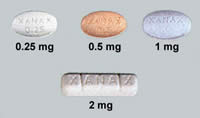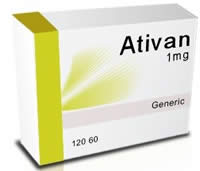Difference between Xanax and Ativan
Key Difference: Xanax, also sold under generic name Alprazolam, is of a benzodiazepine class of psychoactive drugs and is FDA approved for use in treatment of panic disorder, and anxiety disorders, such as generalized anxiety disorder (GAD) or social anxiety disorder (SAD). Ativan, generic name Lorazepam, is a 3-hydroxy benzodiazepine drug that has all six intrinsic benzodiazepine effects: anxiolytic, amnesic, sedative/hypnotic, anticonvulsant, antiemetic and muscle relaxant. This drug also has other uses in addition to being used as an anxiety medicine.
Xanax and Ativan are two types of medications that are most commonly used to treat anxiety and depression. Any use of such medication should be prescribed by a doctor and should be used with great care as they are very susceptible to addiction. Though these medications are both used to treat anxiety, there are significant differences between the pills.
 Xanax, also sold under generic name Alprazolam, is of a benzodiazepine class of psychoactive drugs and is FDA approved for use in treatment of panic disorder, and anxiety disorders, such as generalized anxiety disorder (GAD) or social anxiety disorder (SAD). Benzodiazepines are characterized under minor tranquilizers, which help potentiate the effects of GABA (Gamma-aminobutyric acid) which depresses the central nervous system. It is available in a compressed tablet form or capsule form and is for intake through oral purposes. Alprazolam possesses properties such as anxiolytic, sedative, hypnotic, skeletal muscle relaxant, anticonvulsant, and amnestic properties.
Xanax, also sold under generic name Alprazolam, is of a benzodiazepine class of psychoactive drugs and is FDA approved for use in treatment of panic disorder, and anxiety disorders, such as generalized anxiety disorder (GAD) or social anxiety disorder (SAD). Benzodiazepines are characterized under minor tranquilizers, which help potentiate the effects of GABA (Gamma-aminobutyric acid) which depresses the central nervous system. It is available in a compressed tablet form or capsule form and is for intake through oral purposes. Alprazolam possesses properties such as anxiolytic, sedative, hypnotic, skeletal muscle relaxant, anticonvulsant, and amnestic properties.
Xanax is the more popular medicine, due to its fast onset of action and relief, it takes effect within 8-25 minutes of consumption. The peak benefits are shown within the first hour of ingestion. It also has a short half-life of 10.7–15.8 hours. ‘Half-life’ is the term that is used to describe the time it takes for the medication to completely leave our body. Xanax can also be used to treat nausea that is arises due to chemotherapy. Alprazolam is the most common prescribed and misused benzodiazepine in US.
Alprazolam has shown side-effects such as disinhibition, change in libido, jaundice (very rare), hallucinations (rare), dry mouth (infrequent), ataxia, slurred speech, suicidal ideation (rare), urinary retention (infrequent), skin rash, respiratory depression, constipation, anterograde amnesia, concentration problems, drowsiness, dizziness, lightheadedness, fatigue, unsteadiness, impaired coordination, and vertigo. Since it is easy to become addicted to Alprazolam, withdrawal symptoms for the drug include anxiety, irritability, insomnia, sensory disturbances, mania, schizophrenia, seizure disorders and suicidal tendencies.
Ativan, generic name Lorazepam, is a 3-hydroxy benzodiazepine drug that has all six intrinsic benzodiazepine effects: anxiolytic, amnesic, sedative/hypnotic, anticonvulsant, antiemetic and muscle relaxant. This drug also has other uses in addition to being used as an anxiety medicine. Lorazepam is most commonly used for short-term treatment of anxiety, insomnia, acute seizures including status epilepticus and sedation. Lorazepam is said to have a high addictive potential and abuse potential due to its sedative-hypnotic and anterograde amnesia properties. The US Food and Drug Administration advices that the drug should only be used for a short-term such as 2-4 weeks, and prolonged use should be avoided. Due to it being fast acting, it useful in treating fast onset panic anxiety.

Other medical uses of Lorazepam include insomnia, premedication (in dentistry or endoscopies), reduce anxiety, increase compliance, and induce amnesia, In ICU cases; it can also be used to produce anxiolysis, hypnosis, and amnesia. It can also be used to terminate acute seizures. Lorazepam is also used to treat acute symptoms of vertigo and dizziness for people with Ménière's disease. It has a half-life of 10-20 hours. Lorazepam can be administered via oral, intramuscular, intravenous, sublingual, and transdermal routes.
Lorazepam has side-effects such as sedation, hypotension, confusion, ataxia, anterograde amnesia, hangover effects, impairment of both explicit and implicit memory, depression, dizziness, weakness, unsteadiness, Cognitive impairment, behavioral disinhibition and respiratory depression, hostility, aggression, angry outbursts, psychomotor agitation and suicidal tendencies. It is also a highly addictive drug and withdrawal symptoms include headaches, anxiety, tension, depression, insomnia, restlessness, confusion, irritability, sweating, dysphoria, dizziness, derealization, depersonalization, numbness/tingling of extremities, hypersensitivity to light, sound, and smell, perceptual distortions, nausea, vomiting, diarrhea, appetite loss, hallucinations, delirium, seizures, tremor, stomach cramps, myalgia, agitation, palpitations, tachycardia, panic attacks, short-term memory loss, and hyperthermia.
|
|
Xanax |
Ativan |
|
Generic name |
Alprazolam |
Lorazepam |
|
Properties |
Anxiolytic, sedative, hypnotic, skeletal muscle relaxant, anticonvulsant, and amnestic properties. |
anxiolytic, sedative, hypnotic, amnesic, anticonvulsant, and muscle relaxant properties. |
|
Intake |
Oral |
Oral, intramuscular, intravenous, sublingual, and transdermal |
|
Used to treat |
Panic disorder, anxiety disorders (GAD, SAD), nausea due to chemotherapy, |
Insomnia, premedication (in dentistry or endoscopies), reduce anxiety, increase compliance, and induce amnesia, In ICU cases, it can also be used to produce anxiolysis, hypnosis, and amnesia. Can be used to terminate acute seizure. Lorazepam is also used to treat acute symptoms of vertigo and dizziness for people with Ménière's disease |
|
Side -effects |
Disinhibition, change in libido, jaundice (very rare), hallucinations (rare), dry mouth (infrequent), ataxia, slurred speech, suicidal ideation (rare), urinary retention (infrequent), skin rash, respiratory depression, constipation, anterograde amnesia, concentration problems, drowsiness, dizziness, lightheadedness, fatigue, unsteadiness, impaired coordination, and vertigo. |
Sedation, hypotension, confusion, ataxia, anterograde amnesia, hangover effects, impairment of both explicit and implicit memory, depression, dizziness, weakness, unsteadiness, Cognitive impairment, behavioral disinhibition and respiratory depression, hostility, aggression, angry outbursts, psychomotor agitation and suicidal tendencies. |
|
Half-life |
10.7–15.8 hours |
10-20 hours |
|
Different brands available in market |
Alprax, Alprocontin, Alzam, Anzilum, Apo-Alpraz, Kalma, Niravam, Novo-Alprazol, Nu-Alpraz, Pacyl, Restyl, Tranax, Xycalm, Xanax, Zolam, Zopax |
Ativan, Temesta, Almazine, Alzapam, Anxiedin, Anxira, Anzepam, Aplacasse, Aplacassee, Apo-Lorazepam, Aripax, Azurogen, Bonatranquan, Bonton, Control, Donix, Duralozam, Efasedan, Emotion, Emotival, Idalprem, Kalmalin, Larpose, Laubeel, Lopam, Lorabenz, Loram, Lorans, Lorapam, Lorat, Lorax, Lorazene, Lorazep, Lorazepam, Lorazin, Lorafen (PL), Lorazon, Lorenin, Loridem, Lorivan, Lorsedal, Lorzem, Lozepam, Merlit, Nervistop L, Nervistopl, NIC, Novhepar, Novolorazem, Orfidal, Piralone, Placidia, Placinoral, Punktyl, Quait, Renaquil, Rocosgen, Securit, Sedarkey, Sedatival, Sedizepan, Sidenar, Silence, Sinestron, Somnium, Stapam, Tavor, Titus, Tolid, Tranqil, Tranqipam, Trapax, Trapaxm, Trapex, Upan, Wintin, and Wypax. |
|
Commonly used to treat |
Severe anxiety and panic attacks. |
Fast onset panic anxiety. |
|
FDA advice |
FDA label advices that the physician should periodically reassess the dosage and usefulness of the drug. |
FDA label advises against use of benzodiazepines such as lorazepam for longer than two to four weeks. |
|
Paradoxical reactions |
Aggression, rage, hostility, twitches, tremor, mania, agitation, hyperactivity and restlessness. |
Hostility, aggression, angry outbursts, and psychomotor agitation. |
|
Withdrawal symptoms |
Anxiety, irritability, insomnia, sensory disturbances, mania, schizophrenia, seizure disorders, suicidal tendencies. |
Headaches, anxiety, tension, depression, insomnia, restlessness, confusion, irritability, sweating, dysphoria, dizziness, derealization, depersonalization, numbness/tingling of extremities, hypersensitivity to light, sound, and smell, perceptual distortions, nausea, vomiting, diarrhea, appetite loss, hallucinations, delirium, seizures, tremor, stomach cramps, myalgia, agitation, palpitations, tachycardia, panic attacks, short-term memory loss, and hyperthermia. |
|
Relief time |
The medication starts working 8-25 minutes after ingestion. |
The medication takes time to start working 45 minutes to an hour. |
Image Courtesy: clevespolice.us, allsideeffects.net









Add new comment